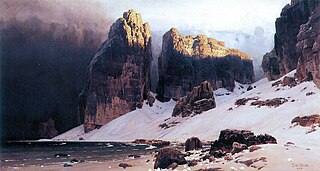Shores of oblivion
| Shores of oblivion |
|---|
| Eugen Bracht |

|
| Original version , 1889 |
| Oil on canvas, 139 cm × 257 cm |
| Hessisches Landesmuseum , Darmstadt |
|
|

|
| Second version , 1911 |
| Oil on canvas, 140.5 cm × 241 cm |
| Westphalian State Museum , Münster |
Shores of Oblivion (usually with the article "Das ...", more rarely "Die ...") is a painting by Eugen Bracht . Eight versions were made between 1889 and 1916. At least two of these have been preserved in museums and are on permanent display. Along with Arnold Böcklin's island of the dead , it is considered one of the most famous works of symbolism .
history
Eugen Bracht mentioned the painting for the first time in a letter to his grandmother on November 18, 1888. In October 1889 he sent the work to the new art gallery at the Rheintor in Darmstadt for an exhibition of Hessian art . The response from the public was so good that it was included in the collection of Grand Duke Ernst Ludwig . The artist received no payment for this, but was honored to be able to give the painting as a gift.
At the same time, a second, almost identical version was created for Kaiser Wilhelm II , who hung it next to Arnold Böcklin's island of the dead . He honored Bracht with the Great Gold Medal for the painting .
Further versions were created in 1897 for the industrialist and art collector Georg Schäfer from Schweinfurt , in 1911 for the Westphalian State Museum in Münster and in 1916 for the writer Börries von Münchhausen . Another version from 1897 is considered lost.
classification
The subject of "death" was rarely dealt with by Eugen Bracht in his work. The painting Shores of Oblivion is seen as a dark fantasy of an end times in which there is no longer any human race.
Individual evidence
- ^ Konstanze Crüwell: Mind painting: An exhibition about Eugen Bracht and his artistic development in the Museum Giersch. In: Frankfurter Allgemeine - Rhein-Main. faz.net, September 23, 2005, accessed March 3, 2016 .
- ↑ Manfred Grosskinsky: Eugen Bracht (1842-1921): Landscape painter in the Wilhelmine Empire . Roether-Druck, Darmstadt 1992, p. 16 .
- ^ Hans-Günther Sperlich: Eugen Bracht 1842-1921 . Darmstadt Art Association, Darmstadt 1970 (No. 23).
- ↑ Eugen Bracht's end-of-time vision “The Shores of Oblivion” can be seen in Bielefeld. In: New Osnabrück Newspaper. noz.de, April 19, 2013, accessed on March 3, 2016 .
